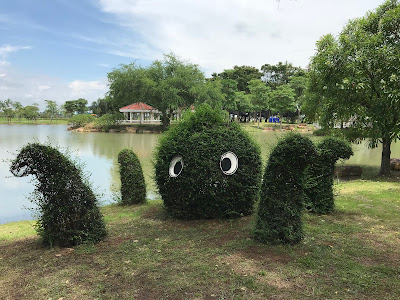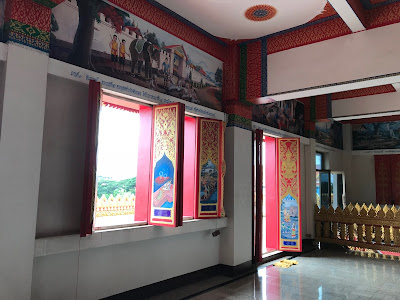I arrived slightly late to the VDU (ventilator-dependent unit) one Friday morning in October only to find that the area had been transformed - from hospital ward to makeshift Buddhist temple. The change had occurred in preparation for the celebration of the 1-year anniversary of the VDU. There had been a similar ceremony one year prior when the unit opened, a common occurrence in Thailand where Buddhism is so deeply connected to everyday life. The current ceremony was an opportunity to celebrate the work that had been done in the previous year and to offer blessings to those who had passed through the VDU - patients, families, providers - and those that would pass through in the future.
The floors of the large VDU lobby were covered in red and yellow wicker mats, at least six or seven consecutive rows, and there was a Buddhist altar and five empty cushions lined up against the wall. The Thai resident I was working with informed me that for an event like this it was important to have an odd number of monks, hence the five cushions. She also pointed out a white thread that was strung around the perimeter of the room near the ceiling. This thread is referred to as “sai sin” and is thought to carry merit and protection. It is used in many Buddhist ceremonies, including weddings and funerals, and is occasionally passed around to everyone in attendance, serving as a physical connection among the people, the monks and the Buddha.
The ceremony included traditional Buddhist chanting in the ancient Pali language, as well as sprinkling of Holy water by the monks, and offerings of gifts of to the monks. Attendees included the family members of current and former VDU patients, nurses from the VDU and critical care department, and the chair of the critical care department, all of whom participated together in these activities. It was really a beautiful event and something that I found to be quite unexpected in the hospital and of course very different from our daily practices in US hospitals.
One of the things that I enjoy most about palliative care is the holistic approach that it offers to patients. Cicely Saunders, the founder of the modern hospice movement, emphasized the concept of “total pain” which includes physical, emotional, spiritual and social pain. The WHO also defines palliative care as a holistic discipline that includes “impeccable assessment and treatment of pain and other problems, physical, psychosocial and spiritual.” Unfortunately, most physicians focus on physical pain and symptoms because this is the approach they were taught in medical school and residency. But of course there are many types of pain and suffering that medications and procedures cannot fix.
Technology cannot answer the question of why an otherwise healthy young man is in a terrible motorcycle accident and is now brain dead, or why a mother with three young children develops metastatic cancer. Technology cannot advise you on how to deal with the painful emotions and existential questions that arise in these situations. This requires human connection, deep listening, and for many people, the wisdom and comfort provided by a spiritual or religious tradition. I think this is one of the reasons I really appreciated the ceremony in the VDU that day. It offered something that was comforting, uplifting and impossible to achieve with technology alone.
I’ve read a number of articles about end of life care in Thailand this year, many of them written by Dr. Scott Stonington, a physician and anthropologist (MD/PhD) who spent a number of years in Thailand doing research in end of life care. In his article titled, “On ethical locations: The good death in Thailand, where ethics sits in places” he describes a discussion that he had with the daughter of a Thai woman who was nearing the end of life. The daughter explained why Thai patients feel that it is better to die at home than in the hospital.
She said, “The hospital is not sacred (saksit). We would make merit (tham bun) and we would put money in her hand and ask for forgiveness (kho khama), but the merit would not get to her as well.”
Dr. Stonington reflects on her words, and how the highly technological environment of the ICU influences the end of life experience,
“We sat together for a moment, and I looked around and saw some of the unsacred in the space around us. The hospital room was an open ward, and half the patients were on mechanical ventilators. The air was sterile and filled with the beeps of machines. Nurses scuffled around with gloves, wheeling blood-pressure check units to the beds of almost corpse-like patients, strapped as modern cyborgs into the life-machines of medical innovation.”
I do not want to speak negatively of the impressive technology we now have available to sustain life, but I do want to emphasize the fact that technology is only one aspect of the care that is needed at the end of life. Although I did not take the time to elaborate about the day to day work in the VDU in this post (as it is already getting quite long!), I will mention that the VDU at Suandok Hospital does an excellent job of providing holistic care to patients on long-term ventilators and in the last stages of life.
I feel grateful that I was able to spend time in the VDU and see this unique approach to care - the warmth and brightness of the VDU contrasted starkly with some of the chronic ventilator-dependent hospitals and nursing homes we have in the US, where patients often seem isolated and lonely. I think key aspects of this were the close involvement of family, the fact that patients were not rushed (many stayed for a month) and the affectionate style of relating to patients that I have noticed among Thai nurses and physicians (it is part of the culture to use kinship terms, e.g. "grandmother", "aunt", "father" when speaking to patients).
I feel grateful that I was able to spend time in the VDU and see this unique approach to care - the warmth and brightness of the VDU contrasted starkly with some of the chronic ventilator-dependent hospitals and nursing homes we have in the US, where patients often seem isolated and lonely. I think key aspects of this were the close involvement of family, the fact that patients were not rushed (many stayed for a month) and the affectionate style of relating to patients that I have noticed among Thai nurses and physicians (it is part of the culture to use kinship terms, e.g. "grandmother", "aunt", "father" when speaking to patients).
I spent a month with first year internal medicine resident "Proud" (nickname) in the ventilator-dependent unit (VDU).
Proud asked me to sit and take a photo with the fruit plate shortly after I arrived. These little fruits are actually a special This dessert made of egg yolk and sugar (อร่อยมาก).
Pouring Holy water (blessed by monks, I think?) at VDU ceremony.
Candles and incense at Wat Phra Singh, a famous temple in the Old City.
Elephant (ช้าง) at Wat Phra Singh.




































